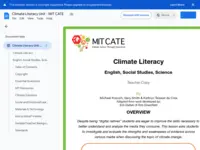Media Climate Literacy
https://docs.google.com/document/d/1m4GQzStAI6DiLD6_cl9CLeBNW9zlqYPl5-aWu6qprOY/edit?tab=t.0#heading=h.az97se5ul39q
https://docs.google.com/document/d/1m4GQzStAI6DiLD6_cl9CLeBNW9zlqYPl5-aWu6qprOY/edit?tab=t.0#heading=h.az97se5ul39q
Michael Kozuch, Gary Smith, Kathryn Teissier du Cros, MIT Center for Energy and Environmental Policy Research
This lesson has students investigate and evaluate the strengths and weaknesses of evidence across various media when discussing the topic of climate change, and includes activities that build student awareness of argumentation techniques using logical fallacies.
This learning activity takes four 60 minute class periods.
Learn more about Teaching Climate Literacy and Energy Awareness»Grade Level
Online Readiness
Topics
Climate Literacy
This Activity builds on the following concepts of Climate Literacy.
Click a topic below for supporting information, teaching ideas, and sample activities.
Notes From Our Reviewers
The CLEAN collection is hand-picked and rigorously reviewed for scientific accuracy and classroom effectiveness.
Read what our review team had to say about this resource below or learn more about
how CLEAN reviews teaching materials
Teaching Tips | Science | Pedagogy |
Technical Details
Teaching Tips
- Consider using this in an English literature/Language Arts setting when discussing logical fallacies.
- This unit could take up multiple class periods, but each lesson could also be taught independently. If you're looking for a single lesson on media literacy, there are multiple options here and each one is well-crafted.
- This resource addresses negative aspects of climate change communication and students may experience feelings of climate anxiety. Consider ways to incorporate solutions and hopeful messages about how to mitigate and adapt to climate change, or other ways to manage climate emotions.
About the Content
- In this series of lessons students learn to analyze different forms of media, identify bias, and discuss examples of reliable sources of information as they relate to climate change denialism in the media.
- This lesson directly addresses common preconceptions and misconceptions. Students will understand the history behind manipulation in the media, and learn about new ways that technology is making it more difficult to identify factual information. This lesson includes information on logical fallacies as well.
- This lesson focuses on social science and communication, specifically evaluating disinformation. It goes into how and why media can be created to purposefully mislead people.
- This is an excellent resource for teaching students how to understand what is credible and what isn't, also going into why science can sometimes seem less valid that the arguments created to discredit it.
- Passed initial science review - expert science review pending.
About the Pedagogy
- This lesson plan utilizes a slide deck, embedded videos, interactive quiz-games, and text to engage a wide variety of audiences.
- There is a detailed lesson plan with denoted time lengths for each section, and it is thoughtfully designed to build upon itself and engage students in a creative way.
- Students work through several forms of information and media manipulation to understand how the fossil fuel industry and allied interests work to discredit climate science.
- The unit ends with a final project. Read the teacher's guide and supplementary materials in advance to help guide students through the final project. Consider presenting completed work to other classes to provide students the opportunity to communicate what they've learned.








